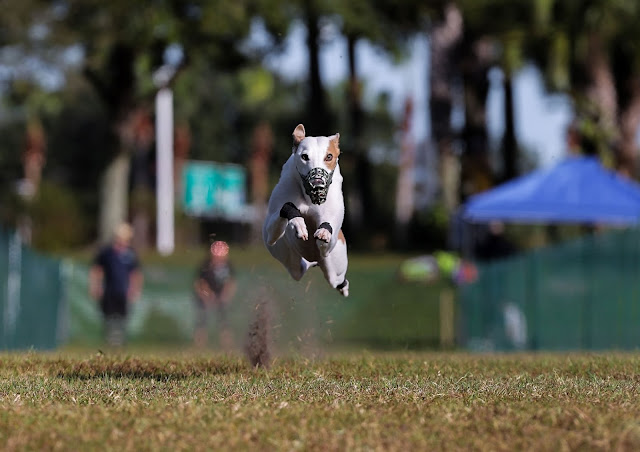Meet Reas, the male white-and-blonde whippet who just won the American Kennel Club's Fastest Dog USA competition 2021.
Reas bolted ahead of the competition to win the second-annual Fastest Dog USA competition.
The three-year-old ran a 100-yard dash in 5.769 seconds or 35.45 miles per hour. That's 0.5777 of a second faster than last year’s winner, Phelan, a mixed-breed rescue dog whose winning time was 6.346 seconds, or 32.3 miles per hour. This year, 250 dogs from 154 breeds competed—more than double the number of competitors in last year’s inaugural race. Phelan's attempting to defend his title resulted in a fifth-place finish, with a time of 6.485 seconds.
The American Kennel Club calls this contest the Fast CAT Invitational—short for coursing ability test. It's part of the AKC’s annual National Championship, a series of competitions that culminates with Best in Show.
For Fast CAT, each dog competes in two categories at preliminary trials, held earlier this week. The first, the Pure Speed category, which recognizes the top 10 dogs in their height class for their speed. The second, Speed of the Breed, which determines the top 10 dogs that run the fastest over the average for their breed.
Whippets, a breed of English sighthound, a group of breeds with lean physiques, long legs, and narrow heads that allow them to reach high speeds.
Descended from greyhounds, whippets are smaller but possess the same sleek build and gentle disposition.
Reas (pronounced REES) isn’t just a speedster, though.
“He likes to do all the stuff,” says Lindsay Gluth, of Michigan City, Indiana, who co-owns Reas with her fiancé, Matt Manetti. She listed a few favorites: dock diving, Frisbee, and barn hunting. But Gluth and Manetti didn’t enter Reas into any of those events here at AKC, opting instead to focus on Fast CAT—a decision that paid off.
The two fastest dogs of each breed participated in the finals race—an average of three 100-yard trials, which was held December 17 at the Orange County Convention Center.
The event is open to all AKC-registered dogs at least a year old, including mixed breeds, which the club refers to as all-American dog.
“Any dog can give it a go, and I think that appeals to people,” says Brandi Hunter Munden, AKC’s vice president of public relations and communications.
Part of the fun of Fast CAT, Munden says, is watching so many different breeds participate in the event. You might see, for instance, a basset hound running the track after a greyhound, or a Pekingese on the heels of a Great Dane.
During the competition, dogs chase a moving lure. Their owners often stand at the finish line, cheering them on. Such a partnership is thousands of years in the making, Brian Hare, a canine cognition researcher at Duke University, says via email.
“Dogs have a unique ability to understand our body language, or our cooperative communicative intentions, in a way that no other species can—including our closest living relatives, the great apes,” says Hare, who has written several books on dog evolution and behavior.
As long as 40,000 years ago, wolves in Germany or Siberia began to hang around human settlements, drawn by food scraps. The friendliest and least skittish animals formed relationships with people, helping them hunt and protecting their homes. Over time, these wolves domesticated themselves into the modern dog—and all its diverse breeds—that we know today.

Comments
Post a Comment